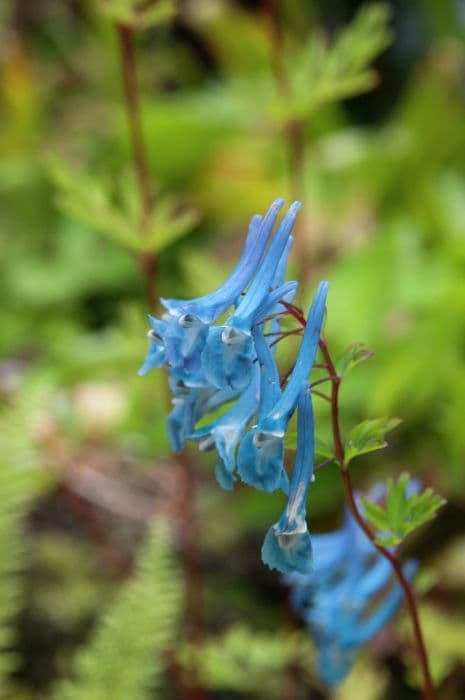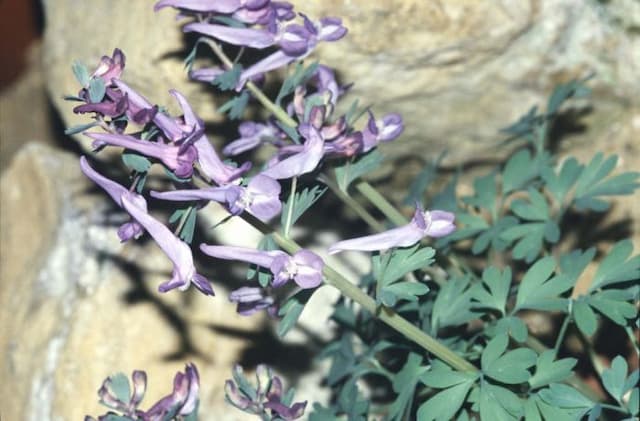Corn poppy Papaver rhoeas 'Angel's Choir Mixed'

ABOUT
'Angel's Choir Mixed' is a variation of the common poppy that boasts a stunning array of flower coloration, ranging from white through pink to soft red. The petals have a delicate, tissue-paper-like quality that can appear almost translucent, with many flowers showcasing a slight variation in hue which adds to their ethereal, choir-like beauty. Each flower contains a dark, central blotch that serves as a striking contrast, further accentuating the lighter petals' shades. The blooms are typically large and bowl-shaped, with a soft, slightly ruffled appearance that provides an impression of gentle movement, as if swaying in a light breeze. This variety of poppy has a solitary flowering habit, with each blossom emerging on its own slender stalk, which is adorned with fine, feathery foliage. The leaves are green, lobed, and hairy, creating a soft, textured background that compliments the delicate nature of the blooms. The plant produces numerous flowers throughout its blooming season, creating a bountiful and picturesque display.
About this plant
 Names
NamesFamily
Papaveraceae.
Synonyms
Corn Poppy, Field Poppy, Flanders Poppy, Red Poppy, Corn Rose.
Common names
Papaver rhoeas 'Angel's Choir Mixed'.
 Characteristics
CharacteristicsLife cycle
Annuals
Foliage type
Deciduous
Color of leaves
Green
Flower color
Mixed
Height
1-2 feet (30-60 cm)
Spread
1 foot (30 cm)
Plant type
Herb
Hardiness zones
2-11
Native area
Eurasia
Benefits
 General Benefits
General Benefits- Attracts Pollinators: Papaver rhoeas, commonly known as corn poppy, attracts bees and butterflies, aiding in pollination.
- Aesthetic Appeal: With its 'Angel's Choir Mixed' variety, it offers a range of colors that enhance garden beauty.
- Easy to Grow: Corn poppies are known for being easy to cultivate in a variety of soil types.
- Self-Seeding: They can self-seed, which means less work for gardeners as the plants can naturally propagate.
- Beneficial for Biodiversity: Supports local ecosystems by providing habitat and food for insects.
- Edible Parts: Some parts of the corn poppy, such as seeds, are edible and can be used in baking and cooking.
- Seasonal Interest: They bloom in spring and early summer, offering seasonal color to gardens.
- Cultural Significance: The corn poppy is a symbol of remembrance and has historical significance in many cultures.
 Medical Properties
Medical Properties- Analgesic: Papaver rhoeas has been traditionally used for its mild analgesic properties, helping to relieve minor pains and aches.
- Antitussive: The plant has been used to treat coughing, as it may help in calming the cough reflex.
- Sedative: Components of the poppy can act as mild sedatives, possibly aiding with sleep disorders or to promote relaxation.
- Anti-inflammatory: It possesses anti-inflammatory properties that might be useful in treating conditions involving inflammation.
- Expectorant: Papaver rhoeas has been used to help in the expulsion of phlegm from the airways.
 Air-purifying Qualities
Air-purifying QualitiesThis plant is not specifically known for air purifying qualities.
 Other Uses
Other Uses- Photographic Subject: The vibrant colors and delicate petals of Papaver rhoeas make it a popular subject for photographers, serving as an appealing focal point in landscape and macro photography.
- Natural Fabric Dyes: The petals can provide a natural source of dyes for fabrics and textiles, introducing a range of reds, pinks, and oranges.
- Eco-Friendly Confetti: Dried petals of Papaver rhoeas can be used as a biodegradable confetti alternative for celebrations, reducing environmental impact.
- Culinary Garnish: Although the plant is not widely known for its culinary uses, its petals can add a colorful garnish to salads and desserts for an extra touch of elegance.
- Floral Crafts: The dried seed pods and petals can be used in crafting, such as in wreaths or arrangements for a rustic, natural aesthetic.
- Botanical Art: The distinct silhouette of Papaver rhoeas seed pods lends itself to being used in botanical art and printmaking projects.
- Ink Production: The deep pigments in the petals can be processed to create natural inks for artistic or calligraphic purposes.
- Decorative Potpourri: Dried petals and pods can be mixed with other botanical elements to create visually appealing and aromatic potpourri blends.
- Educational Tool: The plant can be used in educational settings to demonstrate the life cycle of flowering plants from germination to seed dispersal.
- Mood Setting: In thematic gardens or events, Papaver rhoeas can be strategically planted or displayed to evoke remembrance or the feeling of wildflower fields.
Interesting Facts
 Feng Shui
Feng ShuiThe plant Corn Poppy is not used in Feng Shui practice.
 Zodiac Sign Compitability
Zodiac Sign CompitabilityThe plant Corn Poppy is not used in astrology practice.
 Plant Symbolism
Plant Symbolism- Remembrance: The Papaver rhoeas, commonly known as the common poppy, is a symbol of remembrance, especially for soldiers who have died during wartime. This association comes from World War I, after poppies bloomed on the battlefields of Flanders.
- Peace: Despite its connection with death, the poppy also represents peace due to its use in remembrance rituals and its presence on battlefields after the fighting has ended.
- Rest: The poppy is sometimes seen as a symbol of rest or sleep, referencing the sedative properties of some poppies' opiate derivatives.
- Resilience: As a plant that can grow in disturbed soils, the poppy represents resilience and the ability to thrive in difficult conditions.
- Beauty and Consolation: The delicate beauty of the poppy offers consolation to those who are grieving, serving as a reminder of the beauty of life and the hope that persists in times of sorrow.
 Water
WaterThe common poppy, including the variety 'Angel's Choir Mixed,' should be watered thoroughly but infrequently, allowing the soil to dry out slightly between waterings. Typically, watering once a week with one to two gallons per square yard should be sufficient, but this may need to be increased to twice a week during hot, dry periods. Ensure that you avoid overhead watering to minimize the risk of fungal diseases; instead, water at the base of the plant. Be cautious not to overwater, as poppies prefer well-drained soil and can become susceptible to root rot in overly moist conditions.
 Light
LightCommon poppies require a position in full sunlight to thrive, as they are sun-loving plants. The 'Angel's Choir Mixed' will do best in a spot that gets at least 6-8 hours of direct sunlight daily. Avoid planting in shade or semi-shade areas, as insufficient light can result in poor blooms and weak growth.
 Temperature
TemperatureCommon poppies, like 'Angel's Choir Mixed,' prefer a temperate climate and can withstand temperatures as low as 20°F and as high as 90°F. They are particularly tolerant of cool conditions in the spring and fall. For optimal growth and flowering, maintaining a temperature range of 60°F to 70°F is ideal.
 Pruning
PruningPruning common poppies such as 'Angel's Choir Mixed' mainly involves deadheading spent flowers to encourage more blooms and prevent self-seeding, if not desired. After blooming, cut back the stems to just above the base foliage. Pruning is typically done after the first flush of flowers in late spring or early summer and may be repeated if subsequent blooming occurs.
 Cleaning
CleaningAs needed
 Soil
SoilCommon poppy, or Angel's Choir Mixed, thrives best in well-draining soil rich in organic matter, with a neutral to slightly acidic pH of about 6.5 to 7. A mix of loam, sand, and compost works well for this plant, providing both the nutrients and the drainage required for optimal growth.
 Repotting
RepottingThe common poppy, or Angel's Choir Mixed, does not generally require repotting as it is an annual plant. It completes its life cycle in one growing season and new plants are grown from seed each year.
 Humidity & Misting
Humidity & MistingCommon poppy, or Angel's Choir Mixed, is tolerant of a wide range of humidity levels and does not require high humidity. Average room humidity should be suitable for this plant.
 Suitable locations
Suitable locationsIndoor
Place in a sunny spot and ensure proper drainage for indoor growth.
Outdoor
Sow in well-drained, fertile soil; full sun to partial shade exposure.
Hardiness zone
2-9 USDA
 Life cycle
Life cycleThe common poppy, specifically the cultivated variety 'Angel's Choir Mixed', begins its life as a seed, typically sown directly into the ground where it is to flower, often in autumn or spring. The seed germinates, requiring light, and in a couple of weeks, a small seedling emerges with initial leaves. As the seedling grows, true leaves develop and the poppy plant forms a rosette at ground level, preparing for flowering. During late spring to early summer, depending on the sowing time, the stem elongates, and buds form, which bloom into the characteristic vibrant flowers in various shades that 'Angel's Choir Mixed' is known for. After pollination, typically by insects, the flowers fade, and seed pods develop, maturing and eventually drying to release seeds. The plant completes its annual cycle by dying back, leaving the seeds in the soil to begin the life cycle anew.
 Propogation
PropogationPropogation time
Spring to early summer
Propogation: Papaver rhoeas 'Angel's Choir Mixed', commonly known as the Flanders or common poppy, is typically propagated by seed. The best time to sow these seeds is either in fall or early spring, directly into the ground where they are to flower. Sowing in fall allows the seeds to go through a period of cold stratification naturally, which can help improve germination rates. When sowing, scatter the seeds onto well-weeded soil and lightly rake them in; they need light to germinate, so they should not be buried deeply. Water gently to settle the seeds. Keep the soil slightly moist but not waterlogged, as poppies do not like overwatering. Seedlings will usually emerge in 14 to 28 days under ideal conditions, with temperatures between 60 and 70 degrees Fahrenheit (15.5 to 21 degrees Celsius).









